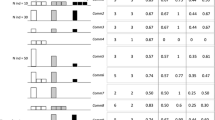Abstract
We study the complementary use of Rao's theory of diversity (1986) and Euclidean metrics. The first outcome is a Euclidean diversity coefficient. This index allows to measure the diversity in a set of species beyond their relative abundances using biological information about the dissimilarity between the species. It also involves geometrical interpretations and graphical representations. Moreover, several populations (e.g., different sites) can be compared using a Euclidean dissimilarity coefficient derived from the Euclidean diversity coefficient. These proposals are used to compare breeding bird communities living in comparable habitat gradients in different parts of the world.
Similar content being viewed by others
References
d'Aubigny, G. (1988) The additive decomposition of some entropy functions and (constrained-) ordination methods. Proceedings of the XVIth International Biometric Conference, Namur, 1988.
Blondel, J., Vuillermier, F., Marcus, L.F., and Terouanne, E. (1984) Is there ecomorphological convergence among mediterranean bird communities of Chile, California and France? In: Evolutionary Biology, M.K. Hecht, B. Wallace, and R.J. MacIntyre (eds), Plenum Press, New York, pp. 141–213.
Gower, J.C. (1966) Some distance properties of latent root and vector methods used in multivariate analysis. Biometrika, 53, 325–88.
Gower, J.C. (1982) Euclidean distance geometry. Mathematical Scientist, 7, 1–14.
Gower, J.C. and Legendre, P. (1986) Metric and Euclidean properties of dissimilary coefficients. Journal of Classification, 3, 5–48.
Patil, G.P. and Taillie, C. (1982) Diversity as a concept and its measurement. Journal of the American Statistical Association, 77, 548–61.
Rao, C.R. (1982) Diversity and dissimilarity coefficients: a unified approach. Theoretical Population Biology, 21, 24–43.
Rao, C.R. (1986) Rao's axiomatization of diversity measures. In: Encyclopedia of Statistical Sciences Volume 7, S. Kotz, N.L. Johnson, and C.R. Read (eds), pp. 614–17.
Rosen, J.B. (1960) The gradient projection method for nonlinear programming. Part I: linear constraints. Journal of the Society for Industrial and Applied Mathematics, 8, 181–217.
Solow, A.R. and Polasky, S. (1994) Measuring biological diversity. Environmental and Ecological Statistics, 1, 95–107.
Thioulouse, J., Chessel, D., Dolédec, S., and Olivier, J.-M. (1997) ADE-4: a multivariate analysis and graphical display software. Statistics and Computing, 7, 75–83.
Author information
Authors and Affiliations
Rights and permissions
About this article
Cite this article
Champely, S., Chessel, D. Measuring biological diversity using Euclidean metrics . Environmental and Ecological Statistics 9, 167–177 (2002). https://doi.org/10.1023/A:1015170104476
Issue Date:
DOI: https://doi.org/10.1023/A:1015170104476




